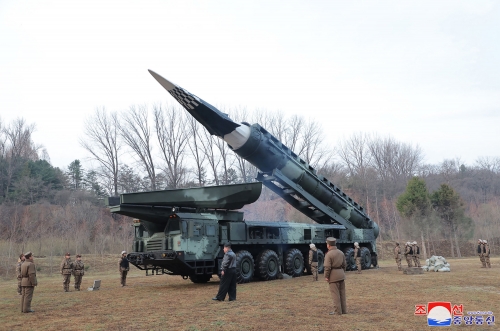North Korea says it test-fired new solid-fuel hypersonic missile
AFP | Seoul
The Daily Tribune – www.newsofbahrain.com
North Korea's Kim Jong Un oversaw the launch of a new medium-to-long range solid-fuel hypersonic missile, state media said Wednesday, hailing the "important military strategic value" of the new weapon.
Video in state media showed the missile being carried into position on its launching vehicle, as Kim and an array of uniformed soldiers stood by watching, before the missile blasts off, trailing plumes of smoke and flames.
With the successful test launch, Kim said the North had developed "another powerful strategic offensive weapon" and achieved its goal of getting missiles "with various ranges on solid-fueled, warhead-controlled and nuclear warhead-carrying basis."
The Tuesday morning test was of a "new-type intermediate-range solid-fueled ballistic missile" loaded with a hypersonic glide warhead, the official Korean Central News Agency said.
"Kim Jong Un went to the launching position and looked round the new-type intermediate-range solid-fueled ballistic missile Hwasongpho-16B loaded with a hypersonic glide warhead to learn in detail about the weapon system," KCNA said.
"Then he mounted the command observation post and received a report on the plan for test-fire of the missile and issued an order to launch it."
The missile travelled some 600 kilometres (372 miles) before splashing down in waters between South Korea and Japan, according to South Korea's military.
KNCA put the figure around 1,000 kilometres, saying it had conducted the test to focus on "verifying the characteristics of gliding-skip flight orbit and cross-range maneuvering capability of the hypersonic glide vehicle" while confining the range "in consideration of safety".
"The test-fire had no adverse effect on the security of neighboring countries," it added.
- 'Serious security threat' -
The launch comes two weeks after Kim supervised a solid-fuel engine test for an intermediate-range hypersonic missile.
North Korea has long sought to master more advanced hypersonic and solid-fuel technologies, to make its missiles more capable of neutralising South Korean-US missile defence systems and threaten America's regional military bases.
Hypersonic missiles are faster and can manoeuvre mid-flight, making them harder to track and intercept, while solid-fuel missiles do not need to be fuelled before launch, making them harder to find and destroy, as well as quicker to use.
Analysts said North Korea's latest demonstration of technical improvements would potentially impact regional security.
"With its improved and unpredictable manoeuvrability it poses a serious security threat that South Korea's missile interception will not work against," Hong Min, a senior analyst at the Korea Institute for National Unification, told AFP.
"While it flew 1,000 km yesterday, it is thought to be capable of up to 3,000 km in range, giving Pyongyang much deterrence against US' aircraft carriers deployed in the region as well as US bases in Guam."
Pyongyang has been under a raft of sanctions since its second nuclear test in 2009, but the development of its nuclear and weapons programmes has continued unabated.
So far this year, the nuclear-armed North has declared South Korea its "principal enemy", jettisoned agencies dedicated to reunification and outreach, and threatened war over "even 0.001 mm" of territorial infringement.
Last month, the United States and South Korea staged one of their major annual joint military exercises, prompting angry retorts and live-fire drills from nuclear-armed Pyongyang, which condemns all such exercises as rehearsals for invasion.
On Tuesday after Pyongyang's latest launch, Seoul's defence ministry said it conducted a joint aerial exercise with Washington and Tokyo involving a nuclear-capable B-52H bomber and F-15K fighter jets near the Korean peninsula.
Related Posts

